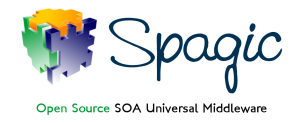Camunda provides a workflow and decision automation platform offering process orchestration capabilities to organizations of any size. Camunda Platform comes from years of research and development including open source initiatives.
The Web Services Business Process Execution Language (WS-BPEL), commonly known as BPEL, is an OASIS standard executable language for specifying actions within business processes with web services. Processes in BPEL export and import information by using web service interfaces exclusively.

Business Process Model and Notation (BPMN) is a graphical representation for specifying business processes in a business process model.
A workflow pattern is a specialized form of design pattern as defined in the area of software engineering or business process engineering. Workflow patterns refer specifically to recurrent problems and proven solutions related to the development of workflow applications in particular, and more broadly, process-oriented applications.

The XML Process Definition Language (XPDL) is a format standardized by the Workflow Management Coalition (WfMC) to interchange business process definitions between different workflow products, i.e. between different modeling tools and management suites. XPDL defines an XML schema for specifying the declarative part of workflow / business process.
Business Process Modeling Language (BPML) is an XML-based language for business process modeling. It was maintained by the Business Process Management Initiative (BPMI) until June 2005 when BPMI and Object Management Group announced the merger of their respective business process management activities to form the Business Modeling and Integration Domain Task Force. It is deprecated since 2008. BPML was useful to OMG in order to enrich UML with process notation.
Workflow Management Coalition (WfMC) was a consortium formed to define standards for the interoperability of workflow management systems. The coalition was disbanded in 2019 and no longer exists.
jBPM is an open-source workflow engine written in Java that can execute business processes described in BPMN 2.0. jBPM is a toolkit for building business applications to help automate business processes and decisions. It's sponsored by Red Hat, part of the JBoss community and closely related to the Drools and OptaPlanner projects in the KIE group. It is released under the ASL by the JBoss company.
BPELscript is a language to specify BPEL processes. It provides a compact syntax inspired by scripting languages such as JavaScript and Ruby and a full coverage of all features provided by BPEL.

Spagic is a Universal Middleware, characterized by an innovative approach to the governance and realization of SOA solutions, which are highly modular and configurable around an OSGi kernel.
Business process management (BPM) is the discipline in which people use various methods to discover, model, analyze, measure, improve, optimize, and automate business processes. Any combination of methods used to manage a company's business processes is BPM. Processes can be structured and repeatable or unstructured and variable. Though not required, enabling technologies are often used with BPM.
ActiveVOS is a business process management suite. Business processes are designed using the graphical BPMN 2.0 notation. The process engine implements the WS-BPEL 2.0 standard as well as BPEL4People for processes that require people to perform tasks from a task list.
Service choreography in business computing is a form of service composition in which the interaction protocol between several partner services is defined from a global perspective. The idea underlying the notion of service choreography can be summarised as follows:
"Dancers dance following a global scenario without a single point of control"
This article provides a comparison of Business Process Model and Notation (BPMN) tools.
Bonita is an open-source business process management and low-code development platform created in 2001. Bonita technology was developed originally in 2001 by Miguel Valdés Faura, at the French Institute for Research in Computer Science and Automation, and subsequently transferred to Groupe Bull. In 2009, the Director of the BPM division, Miguel Valdes Faura, founded Bonitasoft, which is a French open-source software vendor.

Activiti is an open-source workflow engine written in Java that can execute business processes described in BPMN 2.0. Activiti is the foundation for Alfresco's Alfresco Process Services (APS) and Alfresco is the Activiti project's leading sponsor.
ADONIS is a Business Process Management (BPM) tool, used for documentation, analysis, and optimization of business processes. It enables the visualization of process flows and standard operating procedures (SOPs), provides visibility into how they operate, and helps increase their efficiency by revealing redundant efforts and opportunities for improvement.
Imixs Workflow is an Open-Source-Project, providing technologies for building Business Process Management solutions. The project focus on human based workflows used to execute and control workflows in organisations and enterprises. In difference to task-oriented workflow engines, which focus on automated program flow control (tasks), Imixs Workflow is a representative of an event-based workflow engine. Here, the engine controls the status of a process instance within a defined state-diagram. By entering an event, the state of a process instance can be abandoned or changed. In human-centric workflow engines, events usually occur by an interaction of the actor with the system, for example by approving or rejecting a business transaction. They can also be triggered by scheduled events. An example of this is an escalation of an unfinished task.

Flowable is an open-source workflow engine written in Java that can execute business processes described in BPMN 2.0. It is an actively maintained fork of Activiti (software).




